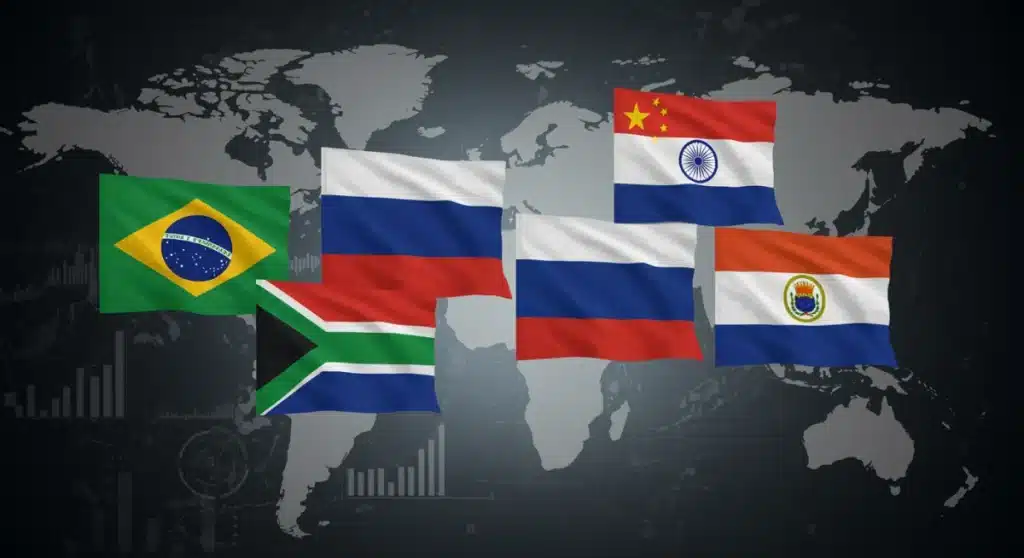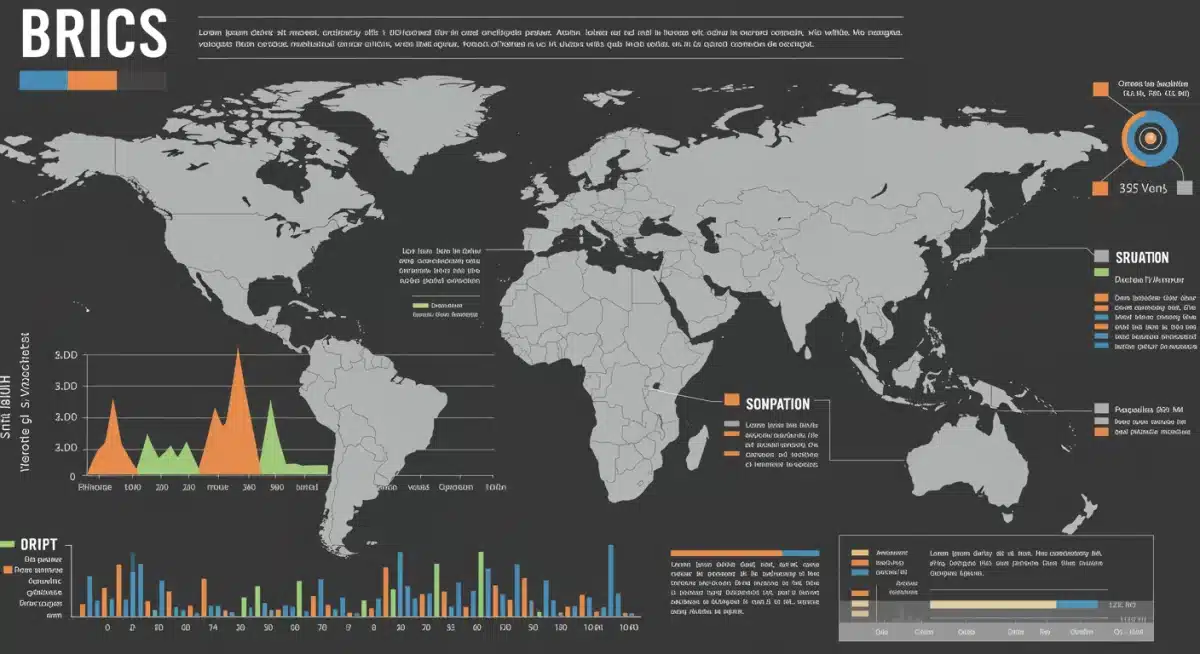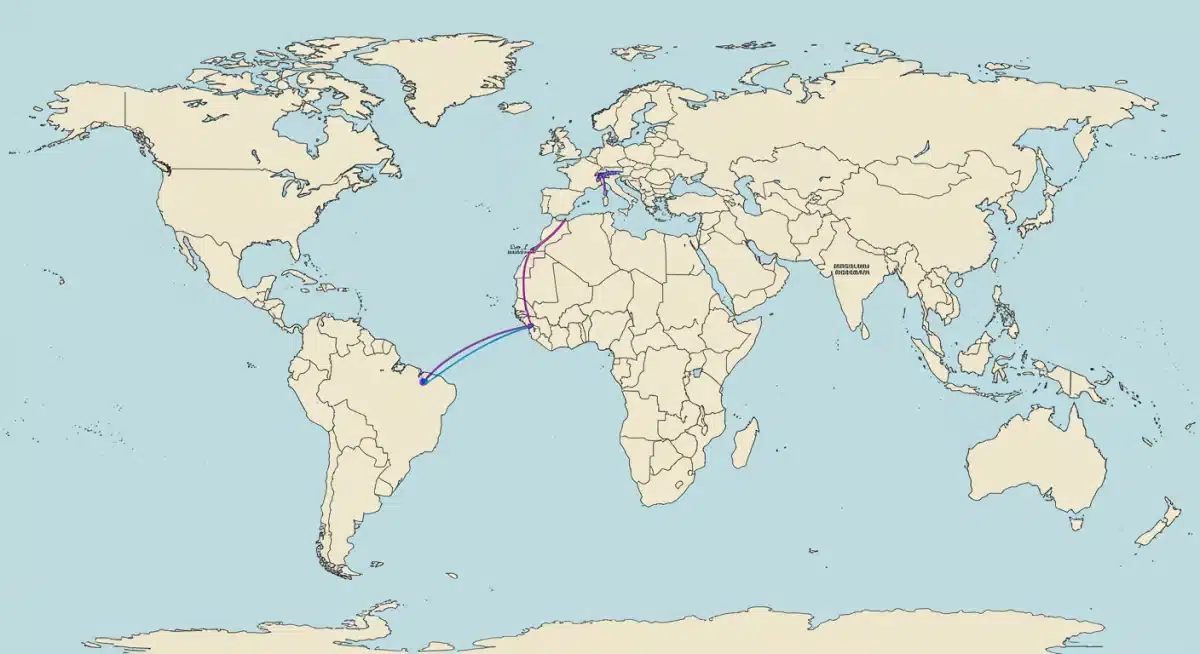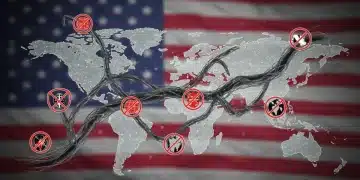BRICS Nations’ Rising Influence: A 2025 U.S. Foreign Policy Briefing

The rising influence of BRICS nations in 2025 necessitates a strategic re-evaluation of U.S. foreign policy to navigate evolving global power dynamics and economic landscapes.
As we approach 2025, the geopolitical landscape continues to evolve at an unprecedented pace, with the collective power of the BRICS nations emerging as a defining force. Understanding BRICS influence US policy is no longer an academic exercise but a critical imperative for policymakers, strategists, and citizens alike. This briefing delves into the multifaceted ways these major emerging economies are reshaping global dynamics and what it means for America’s standing and strategic interests.
The evolving BRICS landscape and its global implications
The BRICS group, comprising Brazil, Russia, India, China, and South Africa, has grown significantly since its inception, both in economic heft and geopolitical ambition. Initially conceived as an economic grouping, it has steadily expanded its mandate, now influencing a broad spectrum of global issues from trade and finance to security and climate change. This expansion poses a direct challenge to the unipolar world order that largely defined post-Cold War international relations.
In 2025, the BRICS nations are projected to command an even larger share of global GDP, surpassing that of the G7 in purchasing power parity terms. This economic leverage translates directly into political influence, enabling them to champion alternative development models and governance structures. Their coordinated actions in international forums, such as the United Nations and the World Trade Organization, are increasingly shaping global norms and challenging traditional Western-led initiatives.
Economic rebalancing and trade dynamics
The economic rise of BRICS members has fundamentally altered global trade patterns. China remains a manufacturing powerhouse and a major consumer market, while India’s burgeoning services sector and domestic consumption are driving robust growth. Brazil and Russia, rich in natural resources, continue to be critical suppliers of raw materials and energy. South Africa serves as a gateway to the African continent, facilitating trade and investment across diverse economies.
- Diversification of supply chains: Many nations are increasingly looking to BRICS members to diversify their supply chains, reducing reliance on single regions.
- Intra-BRICS trade growth: Trade within the BRICS bloc is expanding rapidly, fostering greater economic interdependence among members and creating new economic corridors.
- Challenge to dollar supremacy: Efforts by BRICS nations to promote local currency trade and develop alternative financial mechanisms, like the New Development Bank, are gradually challenging the dominance of the U.S. dollar in international transactions.
The collective economic weight of BRICS nations means that their policy decisions, whether on trade tariffs, investment treaties, or currency valuations, have far-reaching effects across the globe. For the U.S., this necessitates a nuanced approach that balances competition with cooperation, particularly in areas of shared interest like climate action and global health.
Geopolitical shifts and security considerations for the U.S.
Beyond economics, the BRICS nations are actively shaping geopolitical realities, often presenting alternative perspectives to those of the U.S. and its allies. Their growing military capabilities, particularly those of China and Russia, introduce complex security challenges, requiring the U.S. to recalibrate its defense strategies and alliances. India, while maintaining strategic autonomy, increasingly plays a crucial role in regional security, especially in the Indo-Pacific.
The expansion of BRICS, potentially including new members by 2025, further complicates the geopolitical chessboard. Each new member brings its own regional dynamics and strategic interests, making the bloc a more diverse and potentially more influential entity. This expansion could solidify a multipolar world order, where power is diffused among several major centers, rather than concentrated in one or two.
Regional influence and strategic partnerships
BRICS members are actively cultivating stronger regional ties and forging new strategic partnerships that often bypass traditional Western-led frameworks. China’s Belt and Road Initiative, for instance, continues to expand its reach across Asia, Africa, and parts of Europe, creating infrastructure and economic dependencies that favor Beijing. Russia maintains significant influence in Eastern Europe, Central Asia, and parts of the Middle East, often through energy and security agreements.
- African engagement: South Africa’s role in BRICS provides a platform for increased engagement with the African continent, attracting investment and development projects from fellow BRICS members.
- Latin American outreach: Brazil’s diplomatic efforts within BRICS often extend to Latin America, potentially encouraging other regional powers to align with the bloc’s vision of a multipolar world.
- Indo-Pacific dynamics: India’s growing naval power and its strategic partnerships, including with the U.S. through the Quad, reflect a complex balancing act between its BRICS commitments and its broader geopolitical interests.
The U.S. must carefully monitor these evolving regional dynamics, understanding that BRICS-led initiatives can both compete with and complement American foreign policy objectives. Engaging with these partnerships, where appropriate, could unlock new avenues for cooperation and mitigate potential conflicts, while ignoring them risks ceding influence.

U.S. foreign policy adaptation: economic strategies
In response to the rising BRICS influence, U.S. foreign policy must adapt its economic strategies to maintain competitive advantage and promote American interests. This involves a multi-pronged approach that includes strengthening domestic economic resilience, fostering innovative trade agreements, and addressing global economic imbalances. The goal is not to isolate BRICS but to engage constructively while safeguarding U.S. economic security.
One key area of focus is intellectual property protection and fair trade practices. As BRICS economies mature, ensuring a level playing field for American businesses operating in these markets becomes paramount. This also extends to countering unfair subsidies and state-backed enterprises that distort global competition. The U.S. must continue to advocate for a rules-based international economic order, even as new players seek to redefine its parameters.
Reshaping trade and investment frameworks
The U.S. needs to proactively seek new trade and investment opportunities that benefit American workers and businesses. This could involve revitalizing existing trade agreements or forging new ones with strategic partners who share similar economic values. Additionally, encouraging American companies to diversify their investments beyond traditional markets could help mitigate risks associated with geopolitical shifts.
- Focus on critical technologies: Investing in and protecting critical technologies, such as semiconductors, AI, and biotechnology, is essential to maintain U.S. leadership in key sectors.
- Promoting ethical supply chains: Encouraging and supporting the development of ethical and resilient supply chains that prioritize human rights and environmental sustainability can differentiate American products and services.
- Engaging with multilateral institutions: Actively participating in and reforming multilateral economic institutions, such as the IMF and World Bank, can help shape global financial norms to reflect U.S. interests and values.
Economic diplomacy will play a crucial role in this adaptation. The U.S. must leverage its economic prowess to build alliances and foster economic growth in partner nations, creating shared prosperity that can counter alternative economic models promoted by BRICS.
Diplomatic engagement and alliance building
Diplomacy remains the cornerstone of U.S. foreign policy, and in an era of rising BRICS influence, its importance is amplified. The U.S. must engage in robust and consistent diplomatic efforts with BRICS members, seeking areas of common ground while firmly addressing points of divergence. This engagement should be characterized by pragmatism and a clear understanding of mutual interests.
Strengthening existing alliances, such as NATO and partnerships in the Indo-Pacific, is vital for maintaining a united front on issues of global security and democratic values. These alliances provide a collective voice and shared resources to address complex challenges, from regional conflicts to cyber warfare. Furthermore, building new, flexible partnerships with emerging powers that are not part of the BRICS bloc can enhance U.S. influence and responsiveness.
Multilateral cooperation and norm setting
The U.S. has a vested interest in upholding and shaping international norms and institutions. While BRICS nations often advocate for reforms to these institutions, the U.S. can find common ground in addressing global challenges that require collective action. This includes climate change, pandemic preparedness, nuclear non-proliferation, and combating terrorism.
- Dialogue on global governance: Initiating and participating in dialogues about the future of global governance with BRICS members can help prevent fragmentation and promote shared solutions.
- Human rights advocacy: Continuing to advocate for human rights and democratic principles, even when challenging BRICS members, reinforces U.S. values and can resonate with civil society groups globally.
- Conflict resolution: Engaging BRICS nations in conflict resolution efforts, particularly in regions where their interests intersect, can lead to more stable outcomes and reduce humanitarian crises.
Effective diplomacy in 2025 will require a blend of firmness and flexibility, recognizing that BRICS nations are not a monolithic bloc but a diverse group with varying motivations and objectives. Tailored approaches, rather than a one-size-fits-all strategy, will be essential for successful engagement.
Technological competition and cooperation
Technology is a critical arena where the competition and potential for cooperation with BRICS nations will significantly impact U.S. foreign policy. China, in particular, has made massive strides in areas like artificial intelligence, 5G technology, and quantum computing, challenging U.S. dominance. India is also emerging as a global tech hub, particularly in software development and IT services. This technological race has profound implications for economic competitiveness, national security, and global influence.
The U.S. must prioritize investment in its own technological research and development, fostering innovation and maintaining a competitive edge. This includes supporting STEM education, encouraging private sector innovation, and ensuring that regulatory frameworks promote, rather than hinder, technological progress. Simultaneously, establishing clear international norms for responsible technological development and use is crucial to prevent weaponization and misuse.
Cybersecurity and digital infrastructure
As the world becomes increasingly digital, cybersecurity threats and the control of digital infrastructure become central to national security. BRICS nations, with their vast digital populations and growing technological capabilities, are both potential partners and competitors in this domain. Protecting critical infrastructure from cyberattacks and ensuring the security of global data flows are shared concerns.
- International cybersecurity frameworks: Collaborating with BRICS and other nations to develop robust international cybersecurity frameworks and protocols is essential for global digital stability.
- Data governance discussions: Engaging in discussions about data governance, privacy, and sovereignty with BRICS members can help shape a more secure and equitable global digital landscape.
- Promoting open and secure internet: Advocating for an open, interoperable, reliable, and secure internet, free from undue state control, remains a core U.S. foreign policy objective that can find allies within some BRICS members.
While competition in emerging technologies is inevitable, there are also opportunities for cooperation, particularly in addressing global challenges like climate change and disease surveillance, where technological solutions can have a widespread positive impact. Balancing these aspects will define U.S. technological foreign policy in the coming years.

Navigating the human element: values and soft power
Beyond economic and military might, the battle for hearts and minds remains a crucial aspect of international relations. The BRICS nations, particularly China and Russia, are actively promoting their own narratives and values on the global stage, often presenting alternatives to Western liberal democracy. This soft power competition requires the U.S. to reaffirm its values and demonstrate the enduring strength and appeal of its democratic institutions and open society.
Investing in public diplomacy, cultural exchange programs, and educational initiatives can help counter misinformation and build genuine connections with people in BRICS countries and beyond. Showcasing American innovation, creativity, and commitment to human rights can reinforce its global appeal. The U.S. must also address its own domestic challenges, as internal divisions and inequalities can undermine its credibility abroad.
Promoting democratic values and human rights
The U.S. commitment to democratic values and human rights is a cornerstone of its foreign policy. While BRICS nations often prioritize state sovereignty and non-interference, there are opportunities to engage on issues of universal human dignity and fundamental freedoms. This requires consistent messaging and principled action, even when it is diplomatically challenging.
- Support for civil society: Continuing to support independent civil society organizations and human rights defenders in BRICS countries can strengthen democratic aspirations from within.
- Media freedom advocacy: Championing media freedom and access to diverse information sources globally helps counter state-sponsored narratives and promotes a more informed citizenry.
- Educational and cultural exchanges: Expanding educational and cultural exchange programs can foster mutual understanding and build long-term relationships, bridging cultural divides.
The U.S. must recognize that soft power is not about imposing values but about demonstrating their universal appeal through action and example. In a world increasingly shaped by diverse perspectives, the ability to inspire and persuade will be as important as economic or military strength.
Challenges and opportunities for U.S. engagement with BRICS
Engaging with the BRICS nations presents a complex array of challenges and opportunities for U.S. foreign policy in 2025. The challenges include navigating divergent political systems, economic competition, and differing geopolitical interests. However, there are also significant opportunities for collaboration on global issues, economic partnerships, and fostering a more stable international order.
A key challenge lies in managing the internal dynamics of the BRICS bloc itself. While united by a desire for a multipolar world, individual BRICS members often have competing national interests and historical grievances. The U.S. can leverage these internal dynamics to forge bilateral relationships and find common ground on specific issues, rather than treating the bloc as a monolithic adversary.
Strategic foresight and adaptability
The U.S. foreign policy apparatus must be agile and adaptable, capable of responding to rapid changes in the global environment. This requires robust intelligence gathering, expert analysis, and the ability to formulate and implement long-term strategies while also addressing immediate crises. Investing in diplomatic training and developing regional expertise are crucial components of this adaptability.
- Long-term strategic planning: Developing comprehensive long-term strategies that anticipate future trends and potential disruptions related to BRICS influence is essential.
- Scenario planning: Utilizing scenario planning to prepare for various potential outcomes, from increased BRICS cohesion to internal fragmentation, can enhance response capabilities.
- Public-private partnerships: Fostering stronger public-private partnerships can leverage the innovation and resources of the private sector to advance U.S. foreign policy goals related to BRICS.
Ultimately, the rising influence of BRICS nations in 2025 demands a sophisticated and multi-faceted U.S. foreign policy approach. It is not about containment but about strategic engagement, competition, and cooperation to shape a global future that aligns with American values and interests.
| Key Aspect | Brief Description |
|---|---|
| Economic Rebalancing | BRICS nations’ growing GDP and trade volumes reshape global economic power, challenging traditional structures. |
| Geopolitical Shifts | BRICS expansion and strategic partnerships foster a multipolar world, requiring U.S. diplomatic adaptation. |
| Technological Competition | Advances in AI, 5G, and cybersecurity by BRICS members challenge U.S. tech dominance and require strategic responses. |
| U.S. Policy Adaptation | Necessity for robust economic strategies, diplomatic engagement, and alliance building to navigate BRICS influence. |
Frequently asked questions about BRICS and U.S. foreign policy
The primary goal of the BRICS nations is to foster greater economic cooperation among member states and advocate for a more multipolar world order, challenging the dominance of traditional Western-led institutions and promoting alternative development models.
BRICS economic growth presents both challenges and opportunities. It increases global competition and diversifies supply chains but also opens new markets for U.S. goods and services, requiring strategic engagement to maximize benefits and mitigate risks.
Key geopolitical challenges include the potential for a fragmented international system, divergent views on human rights and governance, and competition for influence in critical regions, necessitating careful diplomatic navigation by the U.S.
The U.S. should adopt a nuanced diplomatic strategy that combines robust engagement, alliance strengthening, and targeted cooperation on global issues, while firmly addressing areas of divergence and promoting its core values.
Absolutely. Despite geopolitical differences, the U.S. and BRICS nations share common interests in addressing global challenges like climate change, pandemic preparedness, and nuclear non-proliferation, offering significant avenues for constructive cooperation.
Conclusion
The rising influence of BRICS nations by 2025 is an undeniable reality that will fundamentally reshape the contours of international relations. For U.S. foreign policy, this necessitates a proactive, adaptable, and multifaceted approach that moves beyond traditional frameworks. It requires a delicate balance of competition and cooperation, strengthening alliances while also engaging strategically with BRICS members on issues of mutual concern. By embracing a nuanced understanding of these evolving dynamics, the U.S. can effectively navigate the complexities of a multipolar world, safeguard its interests, and continue to play a leading role in shaping a more stable and prosperous global future.





